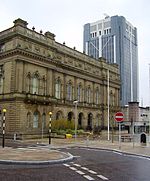Holy Trinity Church, Blackburn
19th-century Church of England church buildingsBuildings and structures in BlackburnChurch of England church buildings in LancashireChurches completed in 1853Churches preserved by the Churches Conservation Trust ... and 8 more
Commissioners' church buildingsDiocese of BlackburnEdmund Sharpe buildingsFormer Church of England church buildingsGothic Revival architecture in LancashireGothic Revival church buildings in EnglandGrade II listed churches in LancashireUse British English from September 2013

Holy Trinity Church is in Mount Pleasant, Blackburn, Lancashire, England. It is a former Anglican parish church which is now redundant and under the care of the Churches Conservation Trust. It is recorded in the National Heritage List for England as a designated Grade II listed building.
Excerpt from the Wikipedia article Holy Trinity Church, Blackburn (License: CC BY-SA 3.0, Authors, Images).Holy Trinity Church, Blackburn
Cleaver Street,
Geographical coordinates (GPS) Address External links Nearby Places Show on map
Geographical coordinates (GPS)
| Latitude | Longitude |
|---|---|
| N 53.7511 ° | E -2.4746 ° |
Address
Holy Trinity Worship Centre
Cleaver Street
BB1 5DG , Little Harwood
England, United Kingdom
Open on Google Maps






